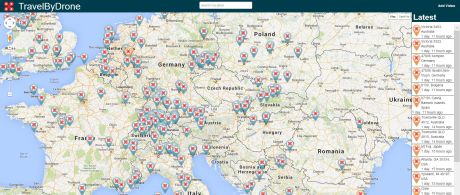It’s all over for Aereo
I suspected it would end like this, but hoped that it wouldn’t. On Wednesday, the Supreme Court sided with broadcasters who had filed a lawsuit against Aereo, a company whose business was to rent you a tiny, dime-sized antenna that resided in their facility, which would in turn stream broadcast network television to your house over the Internet. For $8 a month, you could not only watch the video but record it as well. Below is a diagram of how it works, from deadline.com, which has a thorough and comprehensive Q&A about the company and how it ended up in front of the Supreme Court.
 In effect, Aereo was claiming that because the streams are free in the first place, they are not violating any copyright laws. They’re right on the first part, of course; in fact you can attach any number of broadcast antenna to your house and get network TV for no charge. The broadcasters, however, claimed that it was a violation of copyright law since cable companies are legally bound to pay networks for their content. The Supreme Court agreed, stating in a 6-3 decision that there was no difference between Aereo and a cable company. The dissenting judges stated that because it was the consumer who was doing the watching and Aereo was simply acting as a middleman, the company was not violating any copyright laws.
In effect, Aereo was claiming that because the streams are free in the first place, they are not violating any copyright laws. They’re right on the first part, of course; in fact you can attach any number of broadcast antenna to your house and get network TV for no charge. The broadcasters, however, claimed that it was a violation of copyright law since cable companies are legally bound to pay networks for their content. The Supreme Court agreed, stating in a 6-3 decision that there was no difference between Aereo and a cable company. The dissenting judges stated that because it was the consumer who was doing the watching and Aereo was simply acting as a middleman, the company was not violating any copyright laws.
Again, I suspected this would happen but I’m sad that it did. I cut the cable cord a long time ago, and since all local news streams online anyway and I don’t follow sports (not to mention my spectacular digital media center), it hasn’t been a big deal. But I am someone who believes that many big media companies are clinging too tightly to old business models and they should have found a way to work with Aereo and companies like it to move their business practices and channels forward, rather than continue the pattern of sue-sue-sue. It didn’t work with record labels, whom I actually sided with, and I imagine it won’t work for TV for too much longer.
Also, while researching this article, I found this picture on tapscape.com, which has some good infographics about Aereo, as well as a post that pulls no punches regarding their opinion on the whole thing. In light of the decision, it gave me quite the chuckle.
 One other thing: There are some claims being made that this verdict against Aereo means that the floodgates will open for larger legal actions against cloud services in general. I don’t believe that will happen as Aereo was a specific case and the cloud is so vast, integrated, and critical that it will maintain its existence as it is. If not, well, it would be the Internet equivalent of this.
One other thing: There are some claims being made that this verdict against Aereo means that the floodgates will open for larger legal actions against cloud services in general. I don’t believe that will happen as Aereo was a specific case and the cloud is so vast, integrated, and critical that it will maintain its existence as it is. If not, well, it would be the Internet equivalent of this.
If you are interested in seeing the court’s point of view and why they decided the way they did, you can read their full decision in .pdf form here.
Unbelievable real-time map of global hack attacks
Norse Technologies, one of the leading network-security and monitoring companies, has released an absolutely mesmerizing global map that shows, in real time, global hack attempts, including the type of hack, the origin of the hack, and the intended target. That’s a picture of it in the header, and while writing this post I also was fortunate enough to witness a massive, coordinated attack that you can see in the image below. Fun!
 You can hover over any on-screen element top get more information about that particular attempt. Norse achieves all this by using its own honeypot infrastructure. A honeypot is a type of server that sits between the Internet and a company network, and is intended to look like a regular server on said network. However, it is actually specifically designed to attract hack attempts and fool the attacker into thinking they have successfully gained access to a system or network, all the while while monitoring the attempt and gathering as much information as it can in order to learn about network vulnerabilities or to gather information for a potential prosecution. Honeypot servers can be deployed in several ways, however it is not uncommon for them to have a small amount of actual corporate data on them to maintain the ruse for as long as is required.
You can hover over any on-screen element top get more information about that particular attempt. Norse achieves all this by using its own honeypot infrastructure. A honeypot is a type of server that sits between the Internet and a company network, and is intended to look like a regular server on said network. However, it is actually specifically designed to attract hack attempts and fool the attacker into thinking they have successfully gained access to a system or network, all the while while monitoring the attempt and gathering as much information as it can in order to learn about network vulnerabilities or to gather information for a potential prosecution. Honeypot servers can be deployed in several ways, however it is not uncommon for them to have a small amount of actual corporate data on them to maintain the ruse for as long as is required.
They also mention they are following darknet attacks, but I don’t know why that would be necessary. Darknets are networks that run underneath the Internet, using virtual private networks and tunneling protocols and things of that nature to avoid detection and access (Silk Road, in the news a lot recently, was a darknet used to traffic weapons, drugs, in some cases even people), but there are enough regular attacks that darknet monitoring wouldn’t be necessary. I suspect their use of the term is representative of their own network of honeypot servers.
NOTE: I could only get the site to run smoothly in the Chrome browser, and it’s worth downloading just for this. It worked in Internet Explorer and Firefox after a refresh, but very slowly, so be aware.
Athletic scholarship available for playing League of Legends
It has finally happened. At Robert Morris University, a college in Illinois, the computer game League of Legends is now considered a varsity athletic sport and scholarships are being offered to exceptional competitive players, something they trumpet on their home page.
The fact that it’s considered varsity is important; that means students recruited to play the game for the university are considered athletes, complete with the benefits and considerations that entails, including tutors, financial aid of up to 50 percent off tuition and room and board, leave from class for tournaments, and so on. The college will be recruiting three teams of nine players each.
There are other teams at other universities who play against each other in an unofficial league known as the Collegiate Star League, but this is the first time the game has been officially sanctioned and its players formally considered athletes.
On its face it sounds ridiculous, but “e-sports” as they are called are actually a huge business, with competitive matches drawing thousands of spectators and tens of thousands more online, complete with commentators and analysts. Professional computer and video-game players have been around for a long time, and in recent years it has become very well organized, and more importantly, lucrative.
I personally don’t follow any sport except when the Oilers are playing, and I’m not much of a gamer, so I make no comment as to the legitimacy or validity of the offering. But with the video game industry being one of the most influential in tech and pop culture, bringing in $20 billion a year in revenue (and that was in 2008!), then why not? if golf can be a sport, why not electronic games? Indeed, this may help push it even further into the mainstream, and help schools that host similar teams to consider them the same.
It’s either not a big deal, or the end of the world.
As some of you know, about two months ago I deactivated my Facebook account. I desperately needed a break from all the passive-aggressive posts that cried out for attention yet gave no details (you know, posts like “Well this sucks”), the posts that pleaded with me to “please like and share,” which come across as a desperate cry for validation, and the Foursquare check-ins whose purpose I have yet to understand, but thanks for telling me no one’s at your house for the next two hours. I don’t actually have anything inherent against Facebook, I used it to keep in touch with friends and colleagues from around the world, I just needed a break. Apparently if I log back in everything will come back. I don’t know if I ever will, but never say never.
Anyway, apparently Facebook crashed on Thursday morning for about 30 minutes, making the service unavailable worldwide for millions and millions of users. People began to panic; almost immediately the (sigh) hashtag #WhenFacebookWasDown shot through the roof, and people started posting to rival social media sites such as Twitter and Google+ asking if it was the apocalypse, the rapture, and stating they’d always remember where they were when Facebook died. That, incidentally, led to some hilarious tweets.
As the article states, some pseudo-over-reactionary named John Pudny facetiously lost his mind, tweeting “It’s the end of the world…#Facebook is DOWN!!” I don’t think media reports on that particular tweet, which was widely quoted, picked up on the troll nature of that tweet.
That all happened within 30 MINUTES! It’s not a big deal if a website crashes, people, especially one as massive and non-critical as Facebook. You can go half an hour without it, everyone survived the outage last October when the site went down for hours due to maintenance. It was not a disaster of biblical proportions, there was no human sacrifice, dogs and cats didn’t start living together, but there was plenty of mass hysteria. Now that it’s back up, please like and share this post.
Prototype Integrated Circuit up for Auction (for $1 million plus!)
A prototype of the original integrated circuit developed in 1958 by Jack Kilby at Texas Instruments, and for which he won a Nobel Prize decades later, is going up for auction at the prestigious Christy’s auction house in London and is estimated to bring $1 to $2 million. The integrated circuit was one of the most important inventions in electronics, allowing multiple components such as switches and transistors on a single chip. Today’s computer chips, which are evolutions of the original integrated circuit being auctioned, have *billions* of components which provides for incredible speed and smaller devices.
The integrated circuit was the foundation of the establishment of Moore’s Law, in which Gordon Moore, a co-founder of Intel, stated that the number of components that could fit on an integrated circuit would double approximately every eighteen months to two years, depending on who you ask. That law, which has expanded to refer in a general sense to the evolution of technology itself, has held true ever since, even with naysayers aplenty, including one from Intel itself!.
To be fair, the most important invention in electronics was the Nobel Prize-winning development of the transistor itself by William Shockley, John Bardeen, and Walter Brattain in the late 1940s; the integrated circuit wouldn’t have been possible without it and we would still be using vacuum tubes in computers that were as big as a whole room. It too went through a massive evolution as you can see from the images below: The first is the original transistor they developed, the second is a transistor from today. Progress!
Even so, I am overjoyed that a piece of computing history is expected to bring in so much, it shows that the history and development of technology has value and is appreciated.
On a side note, I was going to link to this article on Engadget that talked about the auction, but it was so badly written I had to find another. I couldn’t even bring myself to use their header image, I had to borrow from hungeree.com instead.
Watch Stephen Hawking Be Hilarious
Just a quick post to highlight the below clip of Stephen Hawking’s appearance on John Oliver’s HBO show “Last Week Tonight.” Although there is some science talk, it is more an example of Dr. Hawking’s exceptional sense of humor, which is to be expected of the smartest man on earth who has also appeared in multiple episodes of both The Simpsons and Futurama (Did I mention his appearances on Futurama?). He also is involved in science, apparently.
The video is below, enjoy it in all its glory.
Take a Drone Tour of the World!
Drones, sometimes known as unmanned aerial vehicles, often conjure up images of aircraft flying over some distant land, coldly piloted by an operator all the way over here in Nevada. That is how they work, by the way, drones flying all over the world are piloted remotely from right here.
In a military capacity, they can deliver lethal strikes, with all the uncertainty and doubt that go along with their use. Even here in the U.S., and in many other countries as well, drones are used for domestic surveillance, with the claim being only where they are needed or believed to be needed. I guess Judas Priest had it right all the way back in 1982 when they penned the eerily prophetic song ‘Electric Eye.’
It can be a difficult subject, and I understand that, but drones aren’t just for dealing aerial death and allowing the government to watch you make a sandwich. They are also used in many private exploits, one being aerial photography. And now, thanks to the website travelbydrone.com, you can see some truly stunning aerial video from around the world that has been captured by these unmanned aerial vehicles.
Keep in mind that nowadays, the term ‘drone’ is being applied to ALL UAVs, not just military grade drones like the one you see in the header. The videos on this website have been captured by everything from industrial drones to hexacopters to model airplanes, and some are accompanied by truly terrible music and camera work. Some, however, are mesmerizing. Also, the webpage is slow to scroll, you’re better off entering a location in the search box and navigating that way.
I’ve included a sample video filmed in New Zealand below. They didn’t film The Hobbit there for nothin’!
Random-stuff-I-Found-Friday!
As I said in my previous post, I love the history of technology as much as as, and in some cases even more, than the present; I consider myself quite the historian when it comes to tech. It’s why I still have a working Atari 2600, Commodore 64, and Apple IIe in my house. So what could be better than combining a vintage aesthetic with modern technology?
Some of you might have seen these before, they’ve been around for about a year, but I just rediscovered them this week. They are vintage advertisements for modern technologies (services, really, but that’s an issue of semantics). You can see Skype, Twitter, Youtube, and Facebook in all their retro glory. Some of the faux technologies in these posters actually did have real-life dopplegangers such as the video phone from 1964. These are great posters, and do an outstanding job of contrasting what was with what is. You can see the posters below.
A return to Antikythera
I always try to inject the history of technology into every class, however for me the history of technology isn’t just about its digital offshoot, but rather technology in general. After all, technology – in a general sense – is using what you know to achieve a goal. I’m as interested in the Oldawan and Acheulean toolmaking industries, the abacus, the slide rule, the ENIAC, and the Analytical Engine as I am in Apple, artificial intelligence, space travel, and bionics.
That is why I was overjoyed to see this story on Sky news, stating that divers will be using the most advanced diving suits ever made to search out the rest of the components of the fabled Antikythera mechanism (that’s a picture of the original up above).
This is really two tech stories in one: The first is the development and use of the diving suits, and the second is the search for the remaining components of the mechanism. I’ll start with the suit.
The exosuit, as it’s called, is a pretty impressive device. It reminds me of a modern version of the Big Daddy from Bioshock. As the article states it’s fully articulated at the joints allowing for full movement, has claws for grasping whatever treasure the diver may find, transmits video via fiber optic cable, and control can even be taken over by people topside in case the diver is rendered incapable. It can operate at 1000 feet, and because it’s fed by cables the diver can stay down as long as necessary. I believe it’s one of the indicators of the future of deep exploration, a great step forward.
But the real story here is the search for the remainder of the mythical Antikythera mechanism. This is a long, involved story so I will try to be brief, yet complete.
In 1901, divers off the coast of Antikythera, Greece, discovered among an ancient wrecked ship what appeared to be a complex, gear-driven device that turned out to be around 2000 years old. It took scientists over 100 years to determine what it was, and how it worked. Eventually it was discovered that this device was used to track all sorts of information in intricate detail: The movement of the stars and planets, tides, predict when both solar and lunar eclipses would take place to name but a few, and it did so accurately to the second. It even accounted for leap years! It is believed by most to have been built by fabled mathematician Archimedes.
It was so advanced that nothing like it had been seen up to that point, and it took another 2000 years (that’s two entire millennia!) before anything even came close to it again. Some say it’s the first analog computer ever made, but simpler machines such as the previously-mentioned abacus could be classified similarly.
The Antikythera mechanism, after extensive investigation and input from many specialists, not to mention many, many years, was slowly recreated digitally and pieced back together. This new dive, then, is incredibly exciting, as it will hopefully piece together some of the lingering questions that still remain. It is my opinion that, with all due respect to the marvelous creations developed throughout computing history, the Antikythera mechanism – because of the time of its development and the precision of its functions – is the single most amazing piece of technology ever created.
I have embedded two full-length documentaries below that examine the device, its restoration and recreation, and the current state of knowledge in regards to it. The first is from the Ancient Discoveries series, the second is from NOVA. They’re both incredibly interesting, you won’t be disappointed!
http://www.youtube.com/watch?v=-KO4-zx9buc
http://www.youtube.com/watch?v=ZeJz2kvkEvM
Fun computer-thingy time!
I posted this last semester and it received positive feedback, so I thought you might like to see it too. That interesting piece of art you see above is actually the result of a tiny program, IOGraph, that tracks mouse movements and converts them into a graphic visualization. Just download it, double-click the program icon and let it run in the background, no install necessary. The above graphic is from about two hours of computer use on my laptop, with the lines being mouse movements and the circles indicating when the mouse was at rest and for how long. I don’t think the colors are relevant but I’m not certain. You can make your own digital art, and the resulting images -which are titled with how long you used the program – are large enough to use as wallpaper!
While it’s a fun diversion, perhaps even offering insight to how you use your machine, it’s actually a good example of an academic discipline known as Human Factors, which is the study of how people interact with things, and how to design those things to facilitate that interaction. It’s a fascinating and interdisciplinary area, combining many areas of study including Computer Science, Psychology, Sociology, and Industrial Design to name a few. There is a technology-based sub-discipline of Human Factors known as Human Computer Interaction (HCI), sometimes also referred to as Human Centered Computing (HCC), that focuses on how people interact with technology and how to design technology to make interacting with it more obvious and intuitive, effective and efficient. It also happens to be the discipline in which I have my Ph.D. This is a good example of the type of tracking tool researchers might use to measure an aspect of a user’s interaction with technology, however the most common of this type of tool is an eye-tracker, which superimposes the target of a user’s gaze on the screen. But mouse-tracking such as this is is used as well. In fact, there’s a function known as Fitts’ Law that measures the accuracy of movement form an origin to a destination, and it has been adapted as a foundational law of HCI/HCC for measuring things like icon placement, size, and design.

The program window is very small and takes up very few resources. It can be minimized to run in the background.
If you would like to look around the program’s page then I certainly encourage you to do that, and you can download the program from there, however the big download link is for Linux, while the download links for Mac and Windows are at the bottom of the page and represented by tiny icons. If you just want to download the thing and get to tracking, for Windows you can click here for the .exe file and for Mac you can click here for the .dmg file (right-click and select ‘save file as’ to control where it downloads).


















